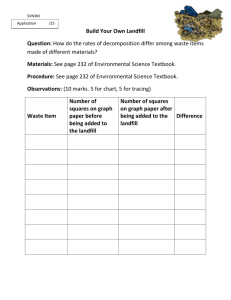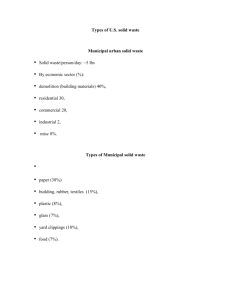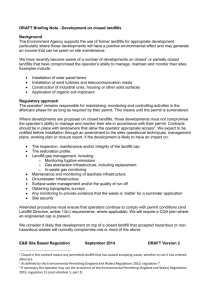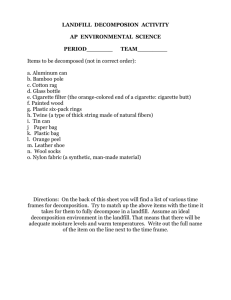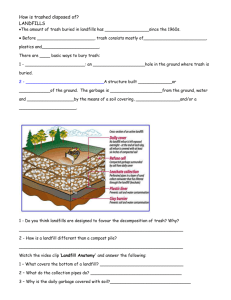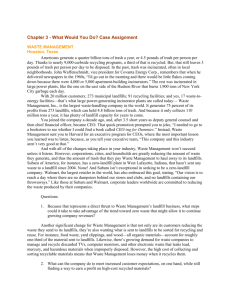The decomposition of paper products in landfills
advertisement
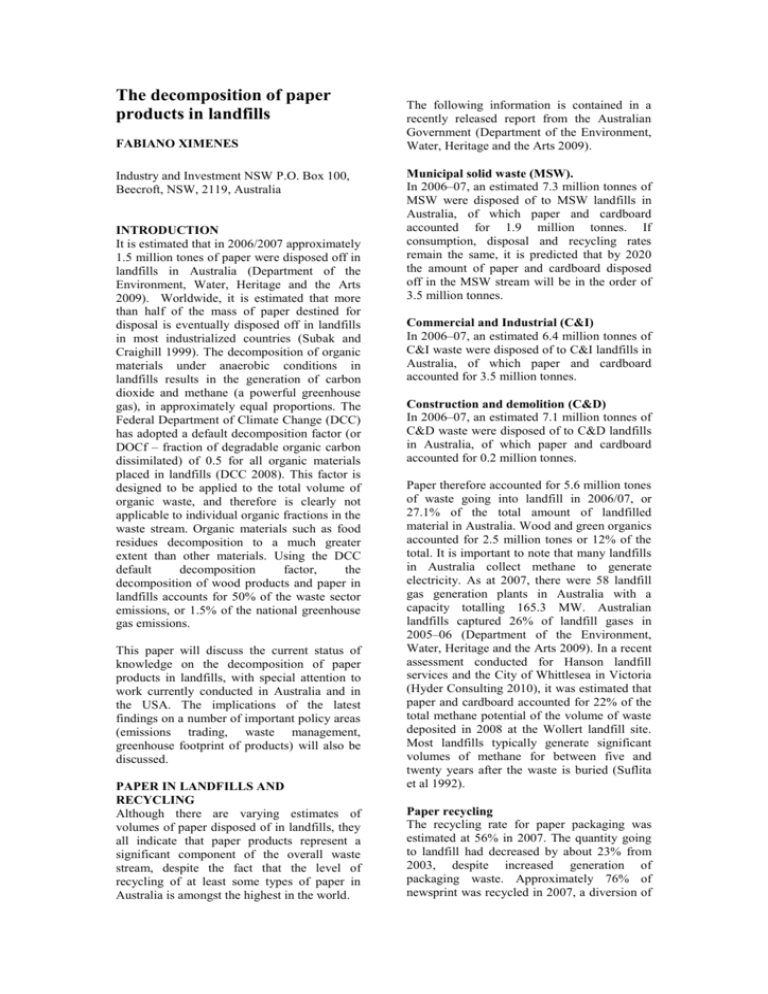
The decomposition of paper products in landfills FABIANO XIMENES Industry and Investment NSW P.O. Box 100, Beecroft, NSW, 2119, Australia INTRODUCTION It is estimated that in 2006/2007 approximately 1.5 million tones of paper were disposed off in landfills in Australia (Department of the Environment, Water, Heritage and the Arts 2009). Worldwide, it is estimated that more than half of the mass of paper destined for disposal is eventually disposed off in landfills in most industrialized countries (Subak and Craighill 1999). The decomposition of organic materials under anaerobic conditions in landfills results in the generation of carbon dioxide and methane (a powerful greenhouse gas), in approximately equal proportions. The Federal Department of Climate Change (DCC) has adopted a default decomposition factor (or DOCf – fraction of degradable organic carbon dissimilated) of 0.5 for all organic materials placed in landfills (DCC 2008). This factor is designed to be applied to the total volume of organic waste, and therefore is clearly not applicable to individual organic fractions in the waste stream. Organic materials such as food residues decomposition to a much greater extent than other materials. Using the DCC default decomposition factor, the decomposition of wood products and paper in landfills accounts for 50% of the waste sector emissions, or 1.5% of the national greenhouse gas emissions. This paper will discuss the current status of knowledge on the decomposition of paper products in landfills, with special attention to work currently conducted in Australia and in the USA. The implications of the latest findings on a number of important policy areas (emissions trading, waste management, greenhouse footprint of products) will also be discussed. PAPER IN LANDFILLS AND RECYCLING Although there are varying estimates of volumes of paper disposed of in landfills, they all indicate that paper products represent a significant component of the overall waste stream, despite the fact that the level of recycling of at least some types of paper in Australia is amongst the highest in the world. The following information is contained in a recently released report from the Australian Government (Department of the Environment, Water, Heritage and the Arts 2009). Municipal solid waste (MSW). In 2006–07, an estimated 7.3 million tonnes of MSW were disposed of to MSW landfills in Australia, of which paper and cardboard accounted for 1.9 million tonnes. If consumption, disposal and recycling rates remain the same, it is predicted that by 2020 the amount of paper and cardboard disposed off in the MSW stream will be in the order of 3.5 million tonnes. Commercial and Industrial (C&I) In 2006–07, an estimated 6.4 million tonnes of C&I waste were disposed of to C&I landfills in Australia, of which paper and cardboard accounted for 3.5 million tonnes. Construction and demolition (C&D) In 2006–07, an estimated 7.1 million tonnes of C&D waste were disposed of to C&D landfills in Australia, of which paper and cardboard accounted for 0.2 million tonnes. Paper therefore accounted for 5.6 million tones of waste going into landfill in 2006/07, or 27.1% of the total amount of landfilled material in Australia. Wood and green organics accounted for 2.5 million tones or 12% of the total. It is important to note that many landfills in Australia collect methane to generate electricity. As at 2007, there were 58 landfill gas generation plants in Australia with a capacity totalling 165.3 MW. Australian landfills captured 26% of landfill gases in 2005–06 (Department of the Environment, Water, Heritage and the Arts 2009). In a recent assessment conducted for Hanson landfill services and the City of Whittlesea in Victoria (Hyder Consulting 2010), it was estimated that paper and cardboard accounted for 22% of the total methane potential of the volume of waste deposited in 2008 at the Wollert landfill site. Most landfills typically generate significant volumes of methane for between five and twenty years after the waste is buried (Suflita et al 1992). Paper recycling The recycling rate for paper packaging was estimated at 56% in 2007. The quantity going to landfill had decreased by about 23% from 2003, despite increased generation of packaging waste. Approximately 76% of newsprint was recycled in 2007, a diversion of over 500,000 tonnes of paper from landfill. All states recycle paper and cardboard from the municipal waste stream with an estimated 940,000 tonnes recycled in 2006–07. Not all states collect data on paper and cardboard recycling from the commercial and industrial waste sector. An estimated 863,000 tonnes were recycled in Victoria, South Australia, Western Australia and the Australian Capital Territory in 2006–07. It is important to note that the same fibre can only be recycled a limited number of times. Given the comparatively short service life of most paper products, the same fibre that has been recycled two or three times may be disposed off in landfills only ten or fifteen years following its use as virgin fibre (if the fibre is not used for a different purpose such as burning for energy generation). Therefore, the landfill stage of the life of most fibres is ultimately what will determine the longevity of the carbon in paper products. REVIEW OF STUDIES ON THE ISSUE OF DECOMPOSITION OF PAPER IN LANDFILLS The number of studies addressing the issue of the decomposition of paper products in landfills, both field-based and laboratorybased, is limited. There have been numerous anecdotal reports of paper products recovered from landfills after a long-period of burial (e.g. Kinman et al., 1990; Bogner, 1990; Rathje and Murphy, 1992, Walsh and LaFleur 1995). Ximenes et al (2008) recovered large volumes of a range of paper products from two sites at one landfill in Sydney. The samples, which had been buried for between nineteen and twenty-nine years, included newspapers, magazines, telephone books, cardboard and office paper (Figure 1). However, only a few studies have attempted to quantify decomposition of paper in landfills. In one of the earliest contributions (Bingemer and Crutzen 1987) it was suggested that paper products degraded entirely within 5-20 years of placement in landfill. This was based on theoretical stoichiometric models. Other authors have attempted to quantify decomposition from samples retrieved from real-life landfills. Baldwin et al (1998) buried samples of newspaper and filter paper in a landfill and periodically sampled the sites over 6 years for analyses. Three sites were chosen representing different climatic conditions. Very little filter paper was recovered from one of the sites, in contrast to the other sites where little decomposition was observed. Total loss of mass for newspapers was generally insignificant - only in the wettest site was there a loss of 17% mass after 2 years. There was a strong correlation between mass loss and lignin content; an increase in lignin content from 0 to 25% reduced total mass losses from 95 to 15%. Chen et al (2004) analysed the decomposition of 15-30 year old excavated newsprint samples, with the aim to detect any changes in the lignin structure of the samples. The lignin concentration of the landfill samples was higher than that of fresh control samples, suggesting some decomposition of the carbohydrate portion of the samples had taken place. Figure 1. Examples of paper products recovered from Lucas Heights landfill in Sydney after 19 years of burial Micales and Skog (1997) conducted an analysis of the likely decomposition of a range of forest products based on results from commercial methane recovery models. They estimated a total mass loss of 15.7% of newspaper, 17.5% of coated paper 31.5% of cardboard boxes and 38.2% of office paper in landfills. Laboratory studies make it possible to control key variables affecting decomposition in landfills (i.e. temperature, moisture content, nutrient availability and microbial presence). Thus, results of such studies represent the ultimate biodegradability of specific waste types, and are very unlikely to be observed in excavated landfill samples, as ideal decomposition conditions are very rarely if ever observed in real life landfills. They can be adopted in the absence of conclusive fieldbased factors, with the understanding that they overestimate the rate and extent of decomposition for some organic materials . Professor Morton Barlaz (North Carolina State University) and his research group have published numerous papers on decomposition of organic materials in landfills, and the US EPA has adopted his results for greenhouse reporting purposes. In an early study (Eleazer et al 1997), a number of paper products made in the USA were shredded and placed underanaerobic conditions in small reactors simulating landfill conditions (with sufficient moisture, nutrients and microbial presence to allow maximum decomposition). Office paper had the most extensive cellulose depletion, and newsprint the lowest (27%). In a more recent report (Barlaz 2004), carbon storage factors (defined as the fraction of the carbon in the original product that is sequestered in landfills) are provided for a number of paper products. They vary from 0.12 for office paper to 0.84 for newspapers, with corrugated boxes and coated paper having carbon storage factors of 0.61 and 0.79, respectively. CURRENT WORK More recent research conducted both in Australia and in the USA strongly suggests that the currently adopted DCC default decomposition factor when applied to paper products in landfills overestimates their greenhouse emissions. The extent of the overestimation is typically linked to the lignin composition of the paper – the higher the lignin composition, the lower the decomposition observed. This section of the paper will discuss the latest field-based and laboratory results on the decomposition of paper products in landfills. As mentioned earlier, large volumes of a range of paper products have been recovered from excavations conducted in both closed and operational MSW (Municipal Solid Waste) landfills in Sydney (Figure 2). The landfill sites included Lucas Heights, Sydney Park, Meadowbank and Eastern Creek. Newspapers, magazines, books, telephone books and office paper have all been recovered and characterized for moisture content, apparent density and chemical composition. Initial visual observations suggested most samples were remarkably sound, although extremely wet (typically the moisture content of samples was above fibre saturation point) and physically damaged by the use of heavy machinery and high compaction in landfill operations. The samples were then dried and ground prior to chemical composition analyses (cellulose, hemicellulose, lignin, ash, extractives). Figure 2. Typical profile of a MSW landfill cell (Eastern Creek landfill, Sydney) Samples that were easily dated (newspapers, telephone books, magazines, paperbacks) were preferentially selected for analyses as in most cases it was possible to source exact matching controls. For example, if a Sydney Morning Herald from April 12, 1990 was recovered, we were able to source a copy of the same newspaper from exactly the same day (or same month if necessary). This provided a perfect opportunity to quantify any carbon loss from the landfill samples by comparing any changes in their chemical composition to those observed in control samples. The same level of rigour could not be applied to samples that were difficult to match with pre-existing controls, such as more obscure publications (e.g. Western Sydney Business Review, 1990), office paper and computer printouts without dates. For these samples all attempts were made to source samples of the same type of paper corresponding to the same time of burial. This represents a suitable method for analyses of paper products recovered from landfills, as unlike solid wood products, the chance of any significant decomposition happening to the paper products during their service life (i.e. prior to burial in landfills) is low. Any significant decomposition during their service life would constitute a confounding factor in the analyses, as not all decomposition would have contributed to methane generation. Therefore, results of analyses from excavated samples can be more easily correlated with those from laboratory experiments. A preliminary analysis of the chemical composition results for the most recent excavation (Eastern Creek site) suggests minimal decomposition after a period of burial ranging from 6 to 18 years. The full results of the research will be published in more detail in a future manuscript. A recent joint research study between Australian and US researchers assessed the biodegradability and methane yield of different types of paper products under controlled, optimum decomposition conditions. The research methodology was similar to that described earlier (Eleazer et al 1997), where a number of paper products were shredded and placed in anaerobic conditions in small reactors simulating landfill conditions (with sufficient moisture, nutrients and microbial presence to allow maximum decomposition). The percentage of carbon emitted from the various paper products as greenhouse gas ranged from 5-45% depending on the paper type (the full results of this research will also be published in more detail in a future manuscript). As discussed earlier, these figures are very unlikely to be observed in excavated landfill samples, as actual decomposition from real-life landfills should be lower. In fact, a preliminary comparison of the results from the research projects described above clearly suggests that, for the same paper product, higher levels of decomposition are measured for the “laboratory” sample compared with the “landfill” sample. It is possible though that more decomposition may take place after eighteen years of burial in landfill, which could potentially bring the results closer. More analyses of paper samples buried for longer periods of time is required to allow a proper comparison of the results. Several factors may contribute to low decomposition observed in previous studies, such as moisture, pH, temperature as well as bioavailability (Barlaz 2006). High concentrations of sulfate, nitrate, iron and manganese may inhibit bacterial action. Gurijala and Suflita (1993) reported that most of the paper samples collected from a landfill were covered with sulfate, absorbed probably from gypsum-based construction and demolition debris. Ink may also play a part in the inhibition of decomposition. In previous studies by Cummings and Stewart (1994 and 1995), it was observed that coating of filter paper with ink halved the activity of bacteria. The ink layer appeared to have masked the cellulose fibres, and bacteria were detected in cellulose fibres exposed by breaks in the ink coating. However, Wu et al (1992) did not observe any difference in the rate and extent of degradation of newsprint due to the presence or absence of ink. The observed level of decomposition was low for all newsprint types tested. The effect of wood type used in the manufacture of paper may also warrant further research. Preliminary results from the current laboratory work suggest that the wood type may play a significant role in the decomposition of paper, particularly for paper types that would be expected to show higher levels of decomposition (i.e. papers with low lignin content). Other factors to consider may include the effect of recycled fiber use versus virgin pulp and the effect of different types of filler . POLICY IMPLICATIONS Research on the decomposition of paper products in landfills may have significant implications for important policy areas such as emissions trading, waste management and the comparison of the greenhouse footprint of products. Emissions Trading Results of the research described above suggest that there is potential for sectors of the paper industry to claim a long-term carbon storage factor for the carbon in paper that ends up in landfill. It is possible that a long-term storage factor for paper products will be ultimately determined by the lignin composition of the paper, which in turn is also correlated with the manufacturing process (mechanical or chemical pulping). The results of the recent research described earlier make a strong case for recognition of long-term storage of carbon in paper products, particularly those with a high lignin concentration. Obviously any methane emissions from the same products would also have to be accounted for. It is important to note that modern landfills collect and burn methane to produce electricity for the grid. In a recent report (Hyder Consulting 2010) it was estimated that the collection efficiency of methane was between 68 to 94% at a modern landfill in Victoria. A mechanism would need to be devised for inclusion and recognition of carbon storage in paper products in the design of any future Emissions Trading Scheme. Issues that would need to be considered would include: Credit / liability ownership (forest grower, pulp and paper manufacturers, printers, landfill operators?); Which products to include – would imported and exported pulp and paper products be excluded from accounting?; Origin of the feedstock – how to ensure that the resource used for the manufacture of the paper originated from eligible forests; Auditing requirements / proof of permanence – need for robust datasets to satisfy strict auditing requirements and which can demonstrate that the carbon in the products is stored for the minimum timeframe required (typically between 70-100 years for carbon accounting). Waste Management The greenhouse benefit of the diversion of specific components of the waste stream such as paper products from landfills is often calculated using the DCC default decomposition factor for organic materials in landfills. The avoided landfill emissions calculated in this fashion are significantly overestimated by the adoption of the DCC default decomposition factor for most types of paper products. As mentioned earlier, adoption of a single default decomposition factor for all organic materials in landfills may be suitable for estimation of emissions from all organic materials in landfills. However, it was not designed to be applied to specific components of the waste stream such as paper products. If the aim is to achieve real reductions in greenhouse gas emissions, it is critical to base any assessment of the greenhouse intensity of different processes on credible science. Otherwise, there is a real risk perverse environmental outcomes will be created. Grant et al (2000) showed that the choice of different decomposition factors for paper products in landfills and acknowledgement of carbon storage can reduce the greenhouse gas benefits of recycling by up to 50%. Greenhouse footprint of products / Life Cycle Assessments (LCAs) For Life Cycle Assessments (LCAs) of paper products that include disposal within their scope, the adoption of lower decomposition factors for paper in landfills may significantly alter the greenhouse footprint outcomes of different products. For instance, greenhouse comparisons between e-paper (billing, online media, etc...) and their printed counterparts may be significantly impacted by the decomposition factor adopted. As mentioned earlier, more than five million tonnes of paper products are disposed of in Australian landfills, even though our recycling rates at least for some types of paper are amongst the highest in the world. The greenhouse footprint of those products that end up in landfill will be significantly impacted by the decomposition factor adopted. CONCLUSIONS Despite the large volumes of paper reaching landfills each year, minimal research has been conducted on the decomposition behaviour of those products under the anaerobic conditions that prevail in landfills. Recent experimental research and research conducted on excavated samples from landfill strongly suggest that a significant proportion of the carbon in a range of paper products can be considered to be stored for the long-term. These results indicate that paper products may play an important role in emissions trading, and also highlight the importance of using less generic decomposition factors when estimating avoided emissions from diverting paper from landfills. ACKNOWLEDGMENTS Thanks to Rebecca Coburn for her help editing the paper. REFERENCES Barlaz, M.A. -. Critical review of forest products decomposition in municipal solid waste landfills. Technical Bulletin No. 872. National Council for Air and Stream Improvement. March 46 p. (2004) Barlaz, M. A. - Forest products decomposition in municipal solid waste landfills. Waste Management, 26: 321 (2006) Bingemer, H.G. and Crutzen, P.J..- The production of methane from solid wastes. Journal of Geophysical Research, 92: 2181 (1987) Bogner, J.E..- Anaerobic burial of refuse in landfills: increased atmospheric methane and implications for carbon storage. Ecological Bulletins, 42: 98 (1992) Chen, L., Nanny, M.A., Knappe, D.R.U, Wagner, T.B., Ratasuk, N. - Chemical characterization and sorption capacity measurements of degraded newsprint from a a landfill. Environmental Science and Technology, 38 (13): 3542 (2004) Cummings, S.P. and Stewart, C.S. Newspaper as a substrate for cellulolytic landfll bacteria. Journal of Applied Bacteriology, 76: 196 (1994) Cummings, S.P. and Stewart, C.S. Methanogenic interactions in model landfill co-cultures with paper as the carbon source. Letters in Applied Microbiology, 20: 286 (1995) Department of the Environment, Water, Heritage and the Arts. - “A national waste policy – managing waste to 2020”. Consultation paper. Australian Government, 62 p. (2009) Department of Climate Change (DCC) National Greenhouse Accounts Factors. Australian Government. November 2008, 65 p. (2008) Eleazer, W.E., Odle, W.S., Wang, Y.-S, Barlaz, M. - Biodegradability of municipal solid waste components in laboratory-scale landfills. Environmental Science and Technology, 31(3): 911 (1997) Grant, T., James, K., Lundie, S. and Sonneveld, K. - Stage 2 Report for Life cycle assessment for paper and packaging waste management in Victoria. EcoRecycle Victoria, 118 p. (2000) Gurijala, K.R. and Suflita, J.M.Environmental factors influencing methanogenesis from refuse in landfills. Environmental Science and Technology, 27: 1176 (1993) Hyder Consulting. Comparative greenhouse gas life cycle assessment of Wollert landfill. Report prepared fro Hanson Landfill Services and the City of Whittlesea, 74 p. (2010) Kinman, R., Rickabaugh, J., Berg, G., Nutini, D. and Rathje, W. - Analysis of 20-year-old refuse from the Mallard North landfill in Chicago, Illinois. Proceedings from the 44 th Purdue Industrial Waste Conference, 527-536. (1990) Micales, J.A. and Skog, K.E. - The decomposition of forest products in landfill. International Biodeterioration and Biodegradation, 39(2): 145 (1997) Rathje, W. and Murphy, C. - Rubbish! The archaeology of garbage. Harper Collins, 250 p. (1992) Subak, S. and Craighill, A. - The contribution of the paper cycle to global warming. Mitigation and Adaptation Strategies for Climate Change, 4: 113 (1999) Suflita, J.M., Gerba, C.P., Ham, R.K., Palmisano, A.C., Rathje, W.L., Robinson, J.A. - The world’s largest landfill. Environmental Science and Technology, 26: 1486 (1992) Walsh, D.C. and LaFleur, R.G. - Landfills in New York City: 1844-1994. Ground Water, 33:556 (1995) Wu, W., Li, D., Ruppel, M., Bhatnagar, L., Hickey, R.F. Anaerobic biodegradability of newsprint-based materials. 47th Purdue Industrial Waste Conference Proceedings, 473486. Lewis Publishers (1992) Ximenes, F.A., Gardner, W.D and Cowie, A. -. The decomposition of wood products in landfills in Sydney, Australia. Waste Management, Vol. 28 (11): 2344 (2008)
